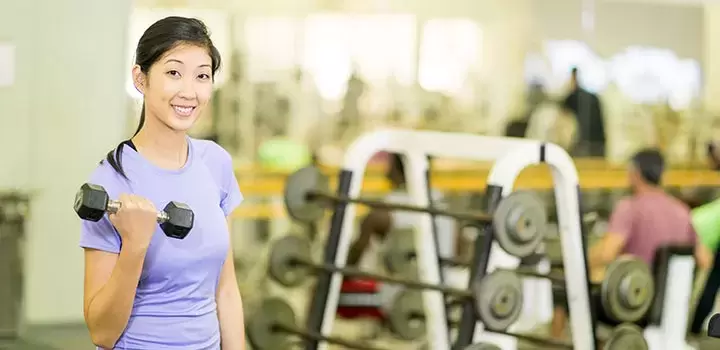Dumbbells are an excellent piece of equipment to have in your exercise toolkit because you can use whatever weight you'd like, wherever you'd like.
To build strength in your arms' major muscle groups, we've put together a dumbbell workout that all ages and experience levels can try with the help of Downtown Nashville YMCA personal trainer Reece Royster.
Before you get started, you'll want to pick out the right dumbbells. Reece recommends choosing weights that you can use for a period of 10 repetitions and 2 sets (a total of 20 repetitions). If you find that your sets are too easy, try adding a few more pounds. If you find yourself straining to finish the sets, move down in weight.
Let's Get Warmed Up
Hammer Curls
- For a basic hammer curl, stand with your feet comfortably shoulder-width apart.
- Stand tall, and focus on bending your elbows, starting with your palms facing up, holding the dumbbells at a 90-degree angle.
- Bring the weights up to your chest.
- When you bring the curl back down, control the motion for a three-count so that you're actively resisting the weight falling back down.
Alternating Overhead Press
- Keep that nice tall stance that you had for your hammer curl.
- Bring your triceps up so that they're parallel to the floor.
- Press up, alternating arms.
- Remember to control the weight as it comes back down.
Ready to tone?
Front/Side Raise
- Keep your feet planted on the floor, slightly wider than shoulder-width apart.
- Keep your chest up and your spine tall, bringing the dumbbells up in front of you with straight arms to shoulder level.
- Count to three as you bring the weights back down slowly.
- For stability purposes, you can hold the dumbbells together so that they're touching.
- For the side raises, bring your straightened arms out on either side of your body and up to ear height.
Tricep Row/Kickback
Grab a bench to work on your triceps and lats.
- Starting with the tricep row, put one knee (on the same side that you're holding the dumbbell) on the bench with the other leg behind on the ground.
- Your opposite hand should be gripping the edge/end of the bench.
- Keep your back flat and your neck in line with your spine, looking down.
- Hold your elbow at a 90-degree angle and bring the dumbbell straight up.
- Once you've reached the top with your elbow, hinge and bring your arm straight back for the "kickback."
- Squeeze and bring the weight back to the row position, making sure that your elbow is still high, and kick your arm back again.
Add in legs.
Bodybuilders
This combination exercise focuses on both your arms and legs.
- Bodybuilders start with a front squat and then move into a hammer curl and overhead press.
- Start in your basic standing position, with your spine tall and your feet shoulder-width apart or slightly wider.
- Do a hammer curl, followed by a squat, and then finish with an overhead press.
- Once you have this rhythm down, try speeding it up into a fluid motion.
- Start with the curl, moving down into the squat, and pressing up through your legs into the overhead press.
- Don't compromise on controlling the weight with your three-count as you bring the dumbbell back down into the starting position.
Exercise Ball Squat with Curl & Front Raise
The great thing about an exercise ball squat is that it assists people who have trouble with squatting—from diverse abilities to injury recovery to weaker joints or muscles. These squats engage the legs but also help to define the correct squatting technique, as you're able to push weight into the ball and use the wall to help you balance.
- Start with the ball on your lower back (in the lumbar region) as the ball will roll up when you squat.
- Hold one dumbbell (one hand on either side of the weight) and come down into a squat, trying to hit a 90-degree angle with your legs.
- To add a curl, widen your stance a little bit. Bring the dumbbell up into a curl as you bring your legs down for the squat.
- As you stand, bring the weight back down into starting position.
- Add a front raise! Keep those arms nice and straight and bring them up in front of your face as you squat.
Exercise Ball Squat with Dumbbell Jabs
Once you have the basic exercise ball squat down, we challenge you to add a few dumbbell jabs.
- This intermediate movement caters to isometric contractions in your legs—meaning that your muscles are not lengthening or shortening; they are staying at a consistent length.
- Come down into a squat, and hold your legs in that 90-degree angle as you alternate punching with the dumbbells.
- If you need a rest, come back up into your leaning/standing position, take a few breaths, and then go back down into your squat.
Keep It Going
Now that you're warmed up, let's keep those muscles working. Try our dumbbell leg workout for beginners.
